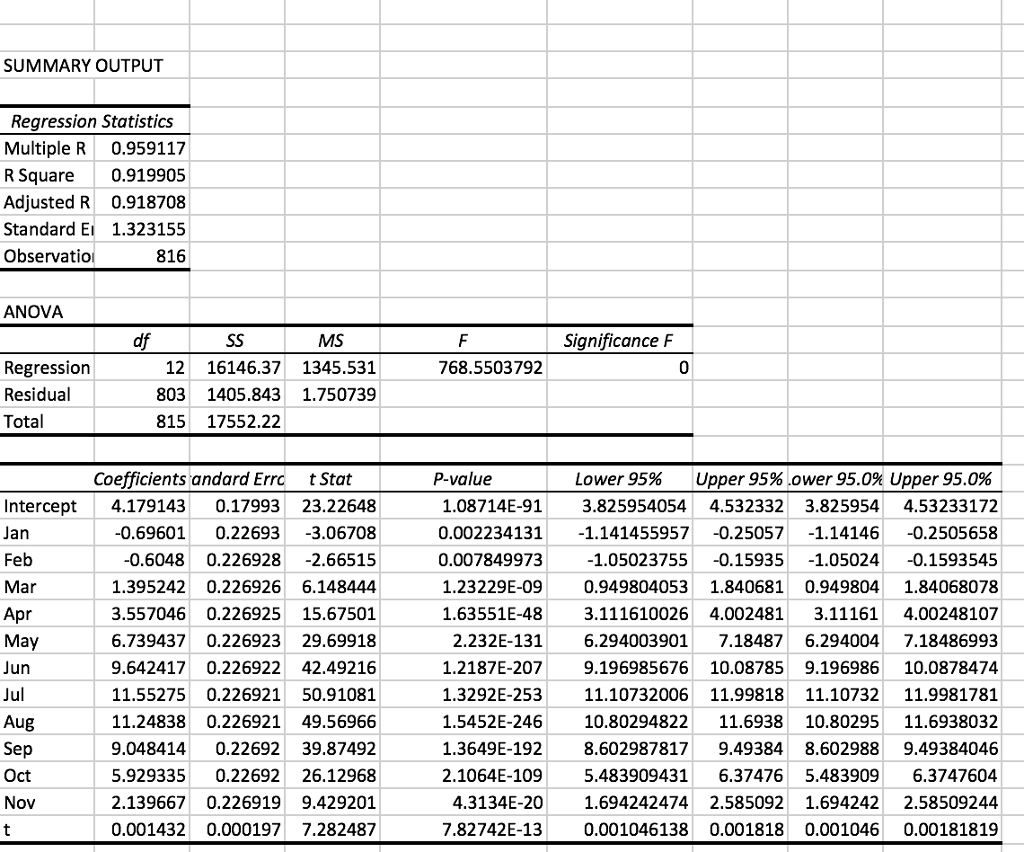Question
The worksheet Data1 of the Excel file CentralEnglandTemp2017 shows the 816 monthly mean (surface air) temperatures for the Midlands region of England between 1950 and
 The worksheet Data1 of the Excel file CentralEnglandTemp2017 shows the 816 monthly mean (surface air) temperatures for the Midlands region of England between 1950 and 2017. (The shown temperatures are in Celsius degrees measured with a precision of 0.1 C.).
The worksheet Data1 of the Excel file CentralEnglandTemp2017 shows the 816 monthly mean (surface air) temperatures for the Midlands region of England between 1950 and 2017. (The shown temperatures are in Celsius degrees measured with a precision of 0.1 C.).
It is quite obvious that the monthly temperatures for Midlands must have a seasonal pattern. But do they have a trend?
Define 12 dummy variables corresponding to 12 months (Jan, Feb,, Dec). Since the categorical variable Month has 12 levels (categories), delete the dummy variable Dec, to assume the regression model with linear trend and seasonality:
,
in which t= time period and is the random error term; see the worksheet Data2. Explain why the dummy variable Dec could be deleted.
Run Regression in Data Analysis of Excel on the worksheet Data2 to find the estimated regression equation:
(In the worksheet Data2, the dependent variable is in the range M1:M817, the independent variables are in the range A1:L817, and do not forget about checking Labels.) Analyze to conclude which month is typically the coldest and which one is the warmest.
You should know that, in the estimated regression equation found in Task 1, the coefficient is the estimated change (increase or decrease) in the average temperature per month. What is the estimated change in the average temperature per year? (Hint. 1 year has 12 months.) What is the estimated change in the average temperature over 100 years?
Using the estimated regression equation found in Task 1, make forecasts for the twelve months of 2018. (Of course, assume t= 817, 818,, 828, respectively, in making these twelve forecasts, and show details of your calculations.) On the website www.metoffice.gov.uk/hadobs/hadcet/cet_info_mean.html, find the actual mean monthly temperatures (CET) recorded for the first nine months of 2018, and compare them with your forecasts by calculating the nine forecast errors. How many of these errors are positive and how many negative? Knowing that February and March of 2018 were exceptionally cold in the entire Western Europe, how this fact is reflected by your February and March 2018 errors?
Interpret your findings in light of the discussion about global warming. Please, feel free to express your opinion.
| Jan | Feb | Mar | Apr | May | Jun | Jul | Aug | Sep | Oct | Nov | t | Temp |
| 1 | 0 | 0 | 0 | 0 | 0 | 0 | 0 | 0 | 0 | 0 | 1 | 4.2 |
| 0 | 1 | 0 | 0 | 0 | 0 | 0 | 0 | 0 | 0 | 0 | 2 | 5.3 |
| 0 | 0 | 1 | 0 | 0 | 0 | 0 | 0 | 0 | 0 | 0 | 3 | 7.4 |
| 0 | 0 | 0 | 1 | 0 | 0 | 0 | 0 | 0 | 0 | 0 | 4 | 7.6 |
| 0 | 0 | 0 | 0 | 1 | 0 | 0 | 0 | 0 | 0 | 0 | 5 | 11.3 |
| 0 | 0 | 0 | 0 | 0 | 1 | 0 | 0 | 0 | 0 | 0 | 6 | 16.2 |
| 0 | 0 | 0 | 0 | 0 | 0 | 1 | 0 | 0 | 0 | 0 | 7 | 15.9 |
| 0 | 0 | 0 | 0 | 0 | 0 | 0 | 1 | 0 | 0 | 0 | 8 | 15.6 |
| 0 | 0 | 0 | 0 | 0 | 0 | 0 | 0 | 1 | 0 | 0 | 9 | 12.9 |
| 0 | 0 | 0 | 0 | 0 | 0 | 0 | 0 | 0 | 1 | 0 | 10 | 9.6 |
| 0 | 0 | 0 | 0 | 0 | 0 | 0 | 0 | 0 | 0 | 1 | 11 | 5.7 |
| 0 | 0 | 0 | 0 | 0 | 0 | 0 | 0 | 0 | 0 | 0 | 12 | 1.2 |
| 1 | 0 | 0 | 0 | 0 | 0 | 0 | 0 | 0 | 0 | 0 | 13 | 3.9 |
| 0 | 1 | 0 | 0 | 0 | 0 | 0 | 0 | 0 | 0 | 0 | 14 | 3.7 |
| 0 | 0 | 1 | 0 | 0 | 0 | 0 | 0 | 0 | 0 | 0 | 15 | 4.1 |
| 0 | 0 | 0 | 1 | 0 | 0 | 0 | 0 | 0 | 0 | 0 | 16 | 6.8 |
| 0 | 0 | 0 | 0 | 1 | 0 | 0 | 0 | 0 | 0 | 0 | 17 | 10.1 |
| 0 | 0 | 0 | 0 | 0 | 1 | 0 | 0 | 0 | 0 | 0 | 18 | 14 |
| 0 | 0 | 0 | 0 | 0 | 0 | 1 | 0 | 0 | 0 | 0 | 19 | 16.3 |
| 0 | 0 | 0 | 0 | 0 | 0 | 0 | 1 | 0 | 0 | 0 | 20 | 14.8 |
| 0 | 0 | 0 | 0 | 0 | 0 | 0 | 0 | 1 | 0 | 0 | 21 | 14.1 |
| 0 | 0 | 0 | 0 | 0 | 0 | 0 | 0 | 0 | 1 | 0 | 22 | 9.4 |
| 0 | 0 | 0 | 0 | 0 | 0 | 0 | 0 | 0 | 0 | 1 | 23 | 8.5 |
| 0 | 0 | 0 | 0 | 0 | 0 | 0 | 0 | 0 | 0 | 0 | 24 | 5.5 |
| 1 | 0 | 0 | 0 | 0 | 0 | 0 | 0 | 0 | 0 | 0 | 25 | 2.7 |
| 0 | 1 | 0 | 0 | 0 | 0 | 0 | 0 | 0 | 0 | 0 | 26 | 3.4 |
| 0 | 0 | 1 | 0 | 0 | 0 | 0 | 0 | 0 | 0 | 0 | 27 | 6.6 |
| 0 | 0 | 0 | 1 | 0 | 0 | 0 | 0 | 0 | 0 | 0 | 28 | 9.6 |
| 0 | 0 | 0 | 0 | 1 | 0 | 0 | 0 | 0 | 0 | 0 | 29 | 13.4 |
| 0 | 0 | 0 | 0 | 0 | 1 | 0 | 0 | 0 | 0 | 0 | 30 | 14.4 |
| 0 | 0 | 0 | 0 | 0 | 0 | 1 | 0 | 0 | 0 | 0 | 31 | 16.8 |
| 0 | 0 | 0 | 0 | 0 | 0 | 0 | 1 | 0 | 0 | 0 | 32 | 15.8 |
| 0 | 0 | 0 | 0 | 0 | 0 | 0 | 0 | 1 | 0 | 0 | 33 | 10.7 |
| 0 | 0 | 0 | 0 | 0 | 0 | 0 | 0 | 0 | 1 | 0 | 34 | 8.8 |
| 0 | 0 | 0 | 0 | 0 | 0 | 0 | 0 | 0 | 0 | 1 | 35 | 4.2 |
| 0 | 0 | 0 | 0 | 0 | 0 | 0 | 0 | 0 | 0 | 0 | 36 | 2.8 |
| 1 | 0 | 0 | 0 | 0 | 0 | 0 | 0 | 0 | 0 | 0 | 37 | 3.3 |
| 0 | 1 | 0 | 0 | 0 | 0 | 0 | 0 | 0 | 0 | 0 | 38 | 4.3 |
| 0 | 0 | 1 | 0 | 0 | 0 | 0 | 0 | 0 | 0 | 0 | 39 | 5.6 |
| 0 | 0 | 0 | 1 | 0 | 0 | 0 | 0 | 0 | 0 | 0 | 40 | 7.3 |
| 0 | 0 | 0 | 0 | 1 | 0 | 0 | 0 | 0 | 0 | 0 | 41 | 12.6 |
Step by Step Solution
There are 3 Steps involved in it
Step: 1

Get Instant Access to Expert-Tailored Solutions
See step-by-step solutions with expert insights and AI powered tools for academic success
Step: 2

Step: 3

Ace Your Homework with AI
Get the answers you need in no time with our AI-driven, step-by-step assistance
Get Started


